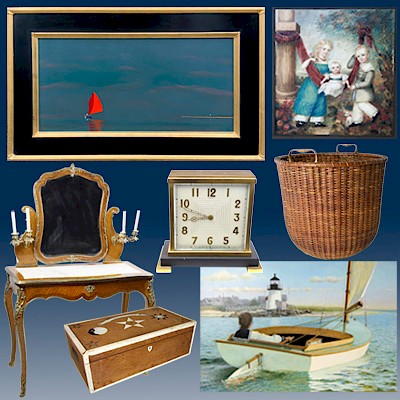Eadweard Muybridge Animal Locomotion – Plate 599, Copyright 1887
Lot 227
About Seller
Rafael Osona Auctions
21 Washington St. , P.O. Box 2607
Nantucket, MA 02584
United States
Recognized since 1980 as a premier dealer in 18th – 21st century Antiques and Arts, our family owned, full service auction house conducts more than a dozen unique auctions annually, reaching regional and global buyers. We showcase exceptional decorative and fine arts in every category. Rafael Osona ...Read more
Categories
Estimate:
$400 - $600
Absentee vs Live bid
Two ways to bid:
- Leave a max absentee bid and the platform will bid on your behalf up to your maximum bid during the live auction.
- Bid live during the auction and your bids will be submitted real-time to the auctioneer.
Bid Increments
| Price | Bid Increment |
|---|---|
| $0 | $25 |
| $250 | $50 |
| $500 | $100 |
| $1,000 | $250 |
| $5,000 | $500 |
| $10,000 | $1,000 |
| $20,000 | $2,500 |
| $50,000 | $5,000 |
| $100,000 | $10,000 |
| $200,000 | $25,000 |
| $500,000 | $50,000 |
About Auction
By Rafael Osona Auctions
Oct 12, 2019
Set Reminder
2019-10-12 09:30:00
2019-10-12 09:30:00
America/New_York
Bidsquare
Bidsquare : Fine Art, Decor and Antiques from Nantucket Estates & Collections
https://www.bidsquare.com/auctions/osona-auctions/fine-art-decor-and-antiques-from-nantucket-estates-collections-4466
Fine & Decorative Arts, Antiques, American & English Furnishings, Nantucket Baskets, South Sea Pearl jewelry, Cartier & Patek Philippe Clocks, Steuben & Lalique Glass, Sterling Silver from Nantucket Collectors and Estates Rafael Osona Auctions info@rafaelosonaauctions.com
Fine & Decorative Arts, Antiques, American & English Furnishings, Nantucket Baskets, South Sea Pearl jewelry, Cartier & Patek Philippe Clocks, Steuben & Lalique Glass, Sterling Silver from Nantucket Collectors and Estates Rafael Osona Auctions info@rafaelosonaauctions.com
- Lot Description
Eadweard Muybridge (English 1830-1904) Animal Locomotion – Plate 599, Copyright 1887, full margins under the mat
Sight 5 ½ in. x 17 ½ in. Overall: 22 in. x 28 in.
Eadweard Muybridge (9 April 1830 – 8 May 1904, born Edward James Muggeridge) was an English photographer important for his pioneering work in photographic studies of motion, and early work in motion-picture projection. He adopted the first name Eadweard as the original Anglo-Saxon form of Edward, and the surname Muybridge believing it to be similarly archaic. At age 20, he emigrated to America as a bookseller, first to New York, and then to San Francisco. Planning a return trip to Europe in 1860, he suffered serious head injuries in a stagecoach crash in Texas. He spent the next few years recuperating in England, where he took up professional photography, learning the wet-plate collodion process, and secured at least two British patents for his inventions. He went back to San Francisco in 1867, and in 1868 his large photographs of Yosemite Valley made him world-famous. In 1874 Muybridge shot and killed Major Harry Larkyns, his wife’s lover, but was acquitted in a jury trial on the grounds of justifiable homicide. He traveled for more than a year in Central America on a photographic expedition in 1875.
Today, Muybridge is known for his pioneering work on animal locomotion in 1877 and 1878, which used multiple cameras to capture motion in stop-motion photographs, and his zoopraxiscope, a device for projecting motion pictures that pre-dated the flexible perforated film strip used in cinematography. In the 1880s, he entered a very productive period at the University of Pennsylvania in Philadelphia, producing over 100,000 images of animals and humans in motion, capturing what the human eye could not distinguish as separate movements.
Muybridge spent much of his later years giving public lectures and demonstrations of his photography and early motion picture sequences, traveling back to England and Europe to publicize his work. He also edited and published compilations of his work, which greatly influenced visual artists and the developing fields of scientific and industrial photography. He returned to his native England permanently in 1894, and in 1904, the Kingston Museum, containing a collection of his equipment, was opened in his hometown.Items may have wear and tear, imperfections or the effects of aging. Please contact the gallery for further details prior to bidding. Any condition statement given as a courtesy should not be treated as fact.Condition
- Shipping Info
-
Please visit https://www.rafaelosonaauction.com/buying/shipping/ for information regarding the collection and shipping of items purchased at auction.
-
- Buyer's Premium



 EUR
EUR CAD
CAD AUD
AUD GBP
GBP MXN
MXN HKD
HKD CNY
CNY MYR
MYR SEK
SEK SGD
SGD CHF
CHF THB
THB













